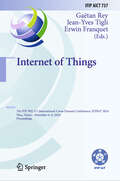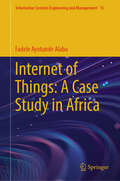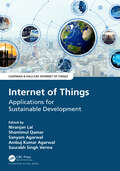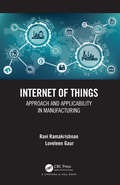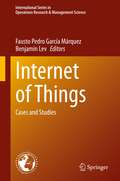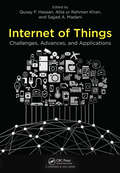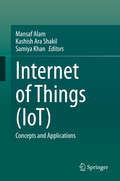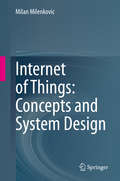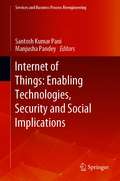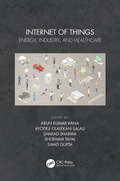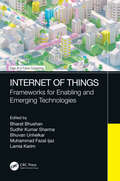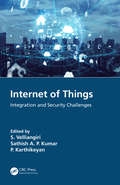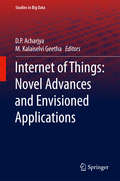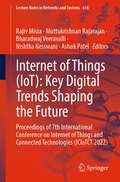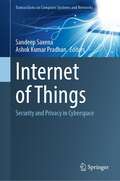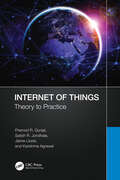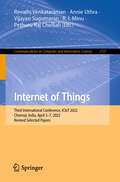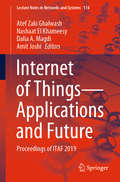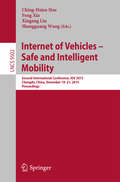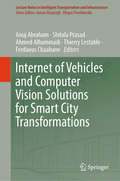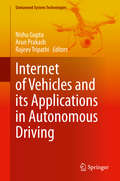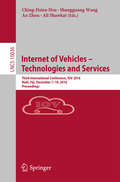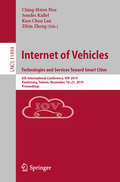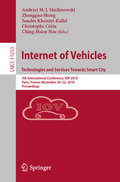- Table View
- List View
Internet of Things: 7th IFIP WG 5.5 International Cross-Domain Conference, IFIPIoT 2024, Nice, France, November 6–8, 2024, Proceedings (IFIP Advances in Information and Communication Technology #737)
by Jean-Yves Tigli Gaëtan Rey Erwin FranquetThis book constitutes the refereed proceedings of the 7th IFIP WG 5.5 International Cross-Domain Conference on Internet of Things, IFIPIoT 2024, in Nice, France, in November 2024.737 The 13 full papers and 4 short papers presented were carefully reviewed and selected from a total of 28 submissions to the main conference. They were organized in topical sections as follows: Hardware/Software Solutions for IoT and CPS; Electronics and Signal Processing for IoT ; Networking and Communications Technology for IoT; Artificial Intelligence and Machine Learning Technologies for IoT; Cyber Security/Privacy/Trust for IoT and CPS and IoT or CPS Applications and Use cases.
Internet of Things: A Case Study in Africa (Information Systems Engineering and Management #13)
by Fadele Ayotunde AlabaExplore the transformative potential of the Internet of Things (IoT) within the unique context of Africa. This comprehensive work delves into the challenges, opportunities, and future trends of IoT, with a particular focus on Nigeria. Readers will discover a novel security framework and defense mechanisms tailored to address the specific needs and vulnerabilities of IoT systems in the African setting. Unlike traditional texts, this book provides a detailed case study approach, illustrating real-world applications and implications of IoT in Africa. It covers a wide range of topics, including the integration of IoT in agriculture, healthcare, and urban development, and highlights both technological advancements and socio-economic impacts. Intended for researchers, practitioners, policymakers, and students, this book offers valuable insights and practical solutions. It serves as an essential resource for anyone looking to understand the dynamic landscape of IoT in Africa and leverage its potential for sustainable development. Key uses of this book include guiding the implementation of IoT projects in developing regions, informing policy formulation, and fostering innovation in IoT security. By addressing the unique challenges faced in Africa, this work stands out as a pivotal reference for advancing IoT technology in similar environments globally.
Internet of Things: Applications for Sustainable Development (Chapman & Hall/CRC Internet of Things)
by Niranjan Lal Shamimul Qamar Sanyam Agarwal Ambuj Kumar Agarwal Sourabh Singh VermaThis book is a compendium of various applications and current progress in a powerful technology known as the Internet of Things (IoT). IoT provides a system of interconnecting things such as vehicles, electrical equipment, agriculture devices, etc. Such items are allocated with the computing device so that they can use a network to transfer data to one another and automate their actions on certain events. Internet of Things: Applications for Sustainable Development will throw light on recent developments in the latest field and will be of great interest to know various application areas for sustainable development. This book mainly focuses on the current state of the art, including protocol design and low-cost sensor design, for the sustainable development of society using IoT. The sustainable development areas include climate, healthcare systems, electrical systems, and energy that can meet present and next-generation advancement using IoT. Sustainable development faces various issues, challenges, opportunities, and future enhancements with the latest technologies, hardware, and software. Features: A real-world problem-solving approach for diversified problems Potential contributors from industries/academia have been given the opportunity to publish their work Identification of various challenges in IoT for future contributions Diversified coverage of the book, including applications, securities, industrialization, automation, etc IoT for the sustainable development areas This book will offer strong support as a reference book for students, practitioners, researchers, and scientific investigators worldwide, as well as anyone who wants to set up IoT-enabled industries. It provides pertinent industries with new ideas and innovations to visionaries.
Internet of Things: Approach and Applicability in Manufacturing
by Ravi Ramakrishnan Loveleen GaurThe concept of Internet of Things has silently existed since the late nineteenth century but in the current decade expectations and excitement has peaked. However not many have understood the profound change that it can usher in. How big this change can be and how it can transform our working!! This book aims to bring in this realization with illustrative and practical case studies with comprehensive concepts. From beginners to practitioners in the field of academics or industry, it serves as a comprehensive yet easy to comprehend source of information on the multiple facets of IoT. Simplistic but comprehensive introduction of the facets of primarily the industrial IoT Practical adoption cases explaining the Core technology stack and business applications Comprehensive view of current technologies which complete the IoT delivery ecosystem, followed by overview of IoT enabled new business models. Realistic view of how industrial firms can evolve into the next stage of maturity along with determinants influencing this transformation since manufacturing is envisioned to be a key segment to adopt and benefit from IoT. Detailed analysis of IoT benefits for the universal triad- energy management, logistics optimization and distribution channel management. A full-fledged case study on Adoption of Green manufacturing using IoT. Real world example of gauging End User perception using different models which is important for a successful adoption of IoT. A futuristic visionary view of IoT as comprehended based on evolution of technology and platforms, and finally analysis of the extremely crucial concepts of security, privacy and governance.
Internet of Things: Cases and Studies (International Series in Operations Research & Management Science #305)
by Fausto Pedro García Márquez Benjamin LevThis book provides relevant theoretical frameworks and the latest empirical research findings of Operations Research/Management Science applied to Internet of Things. This book identifies and describes ways in which OR and MS have been applied and influenced the development of IoT. Examples are from smart industry; city; transportation; home and smart devices. It discusses future applications, trends, and potential benefits of this new discipline. It is written for professionals who want to improve their understanding of the strategic role of IoT at various levels of the organization, that is, IoT at the global economy level, at networks and organizations level, at teams and work groups, at information systems and, finally, IoT at the level of individuals, as players in the networked environments.
Internet of Things: Challenges, Advances, and Applications (Chapman & Hall/CRC Computer and Information Science Series)
by Qusay F. Hassan Atta Ur Khan Sajjad A. MadaniInternet of Things: Challenges, Advances, and Applications provides a comprehensive introduction to IoT, related technologies, and common issues in the adoption of IoT on a large scale. It surveys recent technological advances and novel solutions for challenges in the IoT environment. Moreover, it provides detailed discussion of the utilization of IoT and its underlying technologies in critical application areas, such as smart grids, healthcare, insurance, and the automotive industry. The chapters of this book are authored by several international researchers and industry experts. This book is composed of 18 self-contained chapters that can be read, based on interest. Features: Introduces IoT, including its history, common definitions, underlying technologies, and challenges Discusses technological advances in IoT and implementation considerations Proposes novel solutions for common implementation issues Explores critical application domains, including large-scale electric power distribution networks, smart water and gas grids, healthcare and e-Health applications, and the insurance and automotive industries The book is an excellent reference for researchers and post-graduate students working in the area of IoT, or related areas. It also targets IT professionals interested in gaining deeper knowledge of IoT, its challenges, and application areas.
Internet of Things: Concepts and Applications (S. M. A. R. T. Environments Ser.)
by Mansaf Alam Kashish Ara Shakil Samiya KhanThis books objective is to explore the concepts and applications related to Internet of Things with the vision to identify and address existing challenges. Additionally, the book provides future research directions in this domain, and explores the different applications of IoT and its associated technologies. Studies investigate applications for crowd sensing and sourcing, as well as smart applications to healthcare solutions, agriculture and intelligent disaster management. This book will appeal to students, practitioners, industry professionals and researchers working in the field of IoT and its integration with other technologies to develop comprehensive solutions to real-life problems
Internet of Things: Concepts and System Design
by Milan MilenkovicThis comprehensive overview of IoT systems architecture includes in-depth treatment of all key components: edge, communications, cloud, data processing, security, management, and uses. Internet of Things: Concepts and System Design provides a reference and foundation for students and practitioners that they can build upon to design IoT systems and to understand how the specific parts they are working on fit into and interact with the rest of the system. This is especially important since IoT is a multidisciplinary area that requires diverse skills and knowledge including: sensors, embedded systems, real-time systems, control systems, communications, protocols, Internet, cloud computing, large-scale distributed processing and storage systems, AI and ML, (preferably) coupled with domain experience in the area where it is to be applied, such as building or manufacturing automation. Written in a reader-minded approach that starts by describing the problem (why should I care?), placing it in context (what does this do and where/how does it fit in the great scheme of things?) and then describing salient features of solutions (how does it work?), this book covers the existing body of knowledge and design practices, but also offers the author’s insights and articulation of common attributes and salient features of solutions such as IoT information modeling and platform characteristics.
Internet of Things: Enabling Technologies, Security and Social Implications (Services and Business Process Reengineering)
by Santosh Kumar Pani Manjusha PandeyThis edited book presents point of view and the work being undertaken by active researchers in the domain of IOT and its applications with societal impact. The book is useful to other researchers for the understanding of the research domain and different points of views expressed by the experts in their contributed chapters. The contributions are from both industry and academia; hence, it provides a rich source of both theoretical and practical work going on in the research domain of IOT.
Internet of Things: Energy, Industry, and Healthcare
by Arun Kumar RanaInternet of things (IoT) is the connection and communication of physical objects (smart devices) over the internet. In this recent age, people’s daily lives are dependent on the internet through their smartphones, tablets, Smart TVs, micro-controllers, Smart Tags, computers, laptops, and cars to name a few. This book discusses different ways to create a better IoT network and/or IoT platforms to improve the efficiency and quality of these products and subsequently their users' lives. In addition, this book provides future research directions in energy, industry, and healthcare, and explores the different applications of IoT and its associated technologies. It provides an overview and explanation of the software architecture, middleware, data processing and data management as well as security, sensors, actuators and algorithms used to create a working IoT platform. The editors then go on to examine IoT networks and platforms as they relate to energy industry including, energy efficiency and management, intelligent energy management, smart energy through blockchain and energy-efficient/aware routing/scheduling challenges and issues. They then explore IoT as it applies to healthcare including biomedical image and signal analysis and disease prediction and diagnosis. Finally the editors examine the prospects and applications of IoT for industry through the concepts of smart industry, including architecture, blockchain, and Industry 4.0. This book is intended for senior undergraduate and graduate students, researchers and industry professionals working on IoT applications and infrastructure.
Internet of Things: Frameworks for Enabling and Emerging Technologies (Edge AI in Future Computing)
by Bharat BhushanToday, Internet of Things (IoT) is ubiquitous as it is applied in practice in everything from Industrial Control Systems (ICS) to e-Health, e-commerce, Cyber Physical Systems (CPS), smart cities, smart parking, healthcare, supply chain management and many more. Numerous industries, academics, alliances and standardization organizations make an effort on IoT standardization, innovation and development. But there is still a need for a comprehensive framework with integrated standards under one IoT vision. Furthermore, the existing IoT systems are vulnerable to huge range of malicious attacks owing to the massive numbers of deployed IoT systems, inadequate data security standards and the resource-constrained nature. Existing security solutions are insufficient and therefore it is necessary to enable the IoT devices to dynamically counter the threats and save the system. Apart from illustrating the diversified IoT applications, this book also addresses the issue of data safekeeping along with the development of new security-enhancing schemes such as blockchain, as well as a range of other advances in IoT. The reader will discover that the IoT facilitates a multidisciplinary approach dedicated to create novel applications and develop integrated solutions to build a sustainable society. The innovative and fresh advances that demonstrate IoT and computational intelligence in practice are discussed in this book, which will be helpful and informative for scientists, research scholars, academicians, policymakers, industry professionals, government organizations and others. This book is intended for a broad target audience, including scholars of various generations and disciplines, recognized scholars (lecturers and professors) and young researchers (postgraduate and undergraduates) who study the legal and socio-economic consequences of the emergence and dissemination of digital technologies such as IoT. Furthermore, the book is intended for researchers, developers and operators working in the field of IoT and eager to comprehend the vulnerability of the IoT paradigm. The book will serve as a comprehensive guide for the advanced-level students in computer science who are interested in understanding the severity and implications of the accompanied security issues in IoT. Dr. Bharat Bhushan is an Assistant Professor of Department of Computer Science and Engineering (CSE) at School of Engineering and Technology, Sharda University, Greater Noida, India. Prof. (Dr.) Sudhir Kumar Sharma is currently a Professor and Head of the Department of Computer Science, Institute of Information Technology & Management affiliated to GGSIPU, New Delhi, India. Prof. (Dr.) Bhuvan Unhelkar (BE, MDBA, MSc, PhD; FACS; PSM-I, CBAP®) is an accomplished IT professional and Professor of IT at the University of South Florida, Sarasota-Manatee (Lead Faculty). Dr. Muhammad Fazal Ijaz is working as an Assistant Professor in Department of Intelligent Mechatronics Engineering, Sejong University, Seoul, Korea. Prof. (Dr.) Lamia Karim is a professor of computer science at the National School of Applied Sciences Berrechid (ENSAB), Hassan 1st University.
Internet of Things: Integration and Security Challenges
by S. Velliangiri Sathish A. P. Kumar P. KarthikeyanIoT is empowered by various technologies used to detect, gather, store, act, process, transmit, oversee, and examine information. The combination of emergent technologies for information processing and distributed security, such as Cloud computing, Artificial intelligence, and Blockchain, brings new challenges in addressing distributed security methods that form the foundation of improved and eventually entirely new products and services. As systems interact with each other, it is essential to have an agreed interoperability standard, which is safe and valid. This book aims at providing an introduction by illustrating state-of-the-art security challenges and threats in IoT and the latest developments in IoT with Cloud, AI, and Blockchain security challenges. Various application case studies from domains such as science, engineering, and healthcare are introduced, along with their architecture and how they leverage various technologies Cloud, AI, and Blockchain. This book provides a comprehensive guide to researchers and students to design IoT integrated AI, Cloud, and Blockchain projects and to have an overview of the next generation challenges that may arise in the coming years.
Internet of Things: Novel Advances and Envisioned Applications
by D. P. Acharjya M. Kalaiselvi GeethaThis book focuses on a combination of theoretical advances in the Internet of Things, cloud computing and its real-life applications to serve society. The book discusses technological innovations, authentication, mobility support and security, group rekeying schemes and a range of concrete applications. The Internet has restructured not only global interrelations, but also an unbelievable number of personal characteristics. Machines are increasingly able to control innumerable autonomous gadgets via the Internet, creating the Internet of Things, which facilitates intelligent communication between humans and things, and among things. The Internet of Things is an active area of current research, and technological advances have been supported by real-life applications to establish their soundness. The material in this book includes concepts, figures, graphs, and tables to guide researchers through the Internet of Things and its applications for society.
Internet of Things: Proceedings of 7th International Conference on Internet of Things and Connected Technologies (ICIoTCT 2022) (Lecture Notes in Networks and Systems #616)
by Bharadwaj Veeravalli Ashok Patel Rajiv Misra Muttukrishnan Rajarajan Nishtha KesswaniThe book is a collection of high-quality research papers presented at 7th International Conference on Internet of Things and Connected Technologies (ICIoTCT 2022), held at Indian Institute of Technology (IIT) Patna, Bihar, India during 29–30 September 2022. This book presents recent advances on IoT and connected technologies. This book is designed for marketing managers, business professionals, researchers, academicians, and graduate-level students seeking to learn how IoT and connecting technologies increase the amount of data gained through devices, enhance customer experience, and widen the scope of IoT analytics in enhancing customer marketing outcomes.
Internet of Things: Security and Privacy in Cyberspace (Transactions on Computer Systems and Networks)
by Sandeep Saxena Ashok Kumar PradhanThis book covers major areas of device and data security and privacy related to the Internet of Things (IoT). It also provides an overview of light-weight protocols and cryptographic mechanisms to achieve security and privacy in IoT applications. Besides, the book also discusses intrusion detection and firewall mechanisms for IoT. The book also covers topics related to embedded security mechanisms and presents suitable malware detection techniques for IoT. The book also contains a unique presentation on heterogeneous device and data management in IoT applications and showcases the major communication-level attacks and defense mechanisms related to IoT.
Internet of Things: Theory to Practice
by Jaime Lloret Mauri Satish R. Jondhale Pramod R. Gunjal Karishma AgrawalThis book addresses the fundamental technologies, architectures, application domains, and future research directions of the Internet of Things (IoT). It also discusses how to create your own IoT system according to applications requirements, and it presents a broader view of recent trends in the IoT domain and open research issues. This book encompasses various research areas such as wireless networking, advanced signal processing, IoT, and ubiquitous computing. Internet of Things: Theory to Practice discusses the basics and fundamentals of IoT and real-time applications, as well as the associated challenges and open research issues. The book includes several case studies about the use of IoT in day-to-day life. The authors review various advanced computing technologies—such as cloud computing, fog computing, edge computing, and Big Data analytics—that will play crucial roles in future IoT-based services. The book provides a detailed role of blockchain technology, Narrowband IoT (NB-IoT), wireless body area network (WBAN), LoRa (a longrange low power platform), and Industrial IoT (IIoT) in the 5G world. This book is intended for university/college students, as well as amateur electronic hobbyists and industry professionals who are looking to stay current in the IoT domain.
Internet of Things: Third International Conference, ICIoT 2022, Chennai, India, April 5–7, 2022, Revised Selected Papers (Communications in Computer and Information Science #1727)
by Vijayan Sugumaran Pethuru Raj Chelliah R. I. Minu Annie Uthra Revathi VenkataramanThis book constitutes the refereed and selected papers presented during the Third International Conference on Internet of Things, ICIoT 2022, held in Chennai, India, in April 2022. The 10 papers were thoroughly reviewed and selected from the 100 qualified submissions. They focus on application of IoT in the field of Computer Science and Information Technology as well as on Industrial IoT.
Internet of Things—Applications and Future: Proceedings of ITAF 2019 (Lecture Notes in Networks and Systems #114)
by Amit Joshi Atef Zaki Ghalwash Nashaat El Khameesy Dalia A. MagdiThis book is a collection of the best research papers presented at the First World Conference on Internet of Things: Applications & Future (ITAF 2019), Sponsored by GR Foundation and French University in Egypt, held at Triumph Luxury Hotel, Cairo, Egypt, on 14–15 October 2019. It includes innovative works from leading researchers, innovators, business executives, and industry professionals that cover the latest advances in and applications for commercial and industrial end users across sectors within the emerging Internet of Things ecosphere. It addresses both current and emerging topics related to the Internet of Things such as big data research, new services and analytics, Internet of Things (IoT) fundamentals, electronic computation and analysis, big data for multi-discipline services, security, privacy and trust, IoT technologies, and open and cloud technologies.
Internet of Vehicles - Safe and Intelligent Mobility
by Feng Xia Ching-Hsien Hsu Xingang Liu Shangguang WangThis book constitutes the refereed proceedings of the Second International Conference on Internet of Vehicles, IOV 2015, held in Chengdu, China, in December 2015. The 40 full papers presented were carefully reviewed and selected from 128 submissions. They focus on the following topics: IOV architectures and applications; intelligent mobility; V2V and M2M communications; and modeling and simulations.
Internet of Vehicles and Computer Vision Solutions for Smart City Transformations (Lecture Notes in Intelligent Transportation and Infrastructure)
by Thierry Lestable Anuj Abraham Shitala Prasad Ahmed Alhammadi Ferdaous ChaabaneThis book compiles recent research endeavors at the intersection of computer vision (CV) and deep learning for Internet of Vehicles (IoV) applications, which are pivotal in shaping the landscape of smart cities. These technologies play instrumental roles in enhancing various facets of urban life, encompassing safety, transportation, infrastructure management, and sustainability. The amalgamation of CV and deep learning within smart cities creates a powerful synergy that fosters safer, more efficient, and sustainable urban environments. By harnessing these cutting-edge technologies to drive data-driven decision-making, cities can elevate the quality of life for their inhabitants, mitigate environmental impact, and optimize overall urban functionality. Additionally, this compilation provides in-depth technical and scientific insights into various facets of artificial intelligence (AI) technologies, including forthcoming trends and innovations that are poised to transform smart cities. The book also extends its focus to other areas of smart city development. It explores the application of these technologies in the creation of smart parking solutions, discusses the role of surveillance for public safety, and examines how CV and IoV can be utilized for environmental monitoring. The book also delves into urban planning and infrastructure development, emphasizing the importance of a data-driven approach. It sheds light on the social impact of smart cities and the importance of citizen engagement and discusses issues of security and privacy in the context of smart cities. The book concludes with a look at future trends and challenges in the field of smart cities. Targeted at researchers, practitioners, engineers, and scientists, this book is geared toward those engaged in the development of advanced algorithms for future-forward smart city applications in computer vision, vehicular networking, communication technology, sensor devices, IoT communication, vehicular and on-road safety, data security, and services for IoV-related devices.
Internet of Vehicles and its Applications in Autonomous Driving (Unmanned System Technologies)
by Nishu Gupta Arun Prakash Rajeev TripathiThis book provides an insight on the importance that Internet of Vehicles (IoV) solutions can have in taking care of vehicular safety through internetworking and automation. Key features of the book are the inclusion and elaboration of recent and emerging developments in various specializations of intelligent transportation systems and their solutions by incorporating IoT (Internet of Things) and IoV. This book presents to its readers useful IoV applications and architectures that cater to their improved driving requirements and lead towards autonomous driving. The application domains have a large range in which vehicular networking, communication technology, sensor devices, computing materials and devices, IoT communication, vehicular and on-road safety, data security and other topics are included.
Internet of Vehicles – Technologies and Services
by Ching-Hsien Hsu Shangguang Wang Ao Zhou Ali ShawkatThis book constitutes the refereed proceedings of the Third International Conference on Internet of Vehicles, IOV 2016, held in Nadi, Fiji, in December 2016. The 22 full papers presented were carefully reviewed and selected from 55 submissions. IOV 2016 is intended to play an important role for researchers and industry practitioners to exchange information regarding advancements in the state of art and practice of IOV architectures, protocols, services, and applications, as well as to identify emerging research topics and define the future directions of IOV.
Internet of Vehicles. Technologies and Services Toward Smart Cities: 6th International Conference, IOV 2019, Kaohsiung, Taiwan, November 18–21, 2019, Proceedings (Lecture Notes in Computer Science #11894)
by Zibin Zheng Ching-Hsien Hsu Sondès Kallel Kun-Chan LanThis book constitutes the proceedings of the 6th International Conference on the Internet of Vehicles, IOV 2019, which took place in Kaohsiung, Taiwan, in November 2019. The 23 papers presented in this volume were carefully reviewed and selected from 101 submissions. The papers focus on providing new efficient solutions with digital intervehicular data transfer and overall communications. Yet, IOV is different from Telematics, Vehicle Ad hoc Networks, and Intelligent Transportation, in which vehicles like phones can run within the whole network, and obtain various services by swarm intelligent computing with people, vehicles, and environments.
Internet of Vehicles. Technologies and Services Towards Smart City: 5th International Conference, IOV 2018, Paris, France, November 20–22, 2018, Proceedings (Lecture Notes in Computer Science #11253)
by Ching-Hsien Hsu Andrzej M.J. Skulimowski Zhengguo Sheng Sondès Khemiri-Kallel Christophe CérinThis book constitutes the proceedings of the 5th International Conference on the Internet of Vehicles, IOV 2018, which took place in Paris, France, in November 2018. This year’s theme was “Technologies and Services Towards Smart City”. The 21 papers presented in this volume were carefully reviewed and selected from 41 submissions. The papers are organized in topical sections named: IoV communications and networking; IoV clouds and services; vehicular modeling and simulation; and vehicular security and privacy.
Internet para todos
by Jaime A. Restrepo"Con Internet para todos, dar el primer paso para adentrarse en el mundo de las computadoras no es mas difícil que aprender a montar en bicicleta. Una vez que usted pierda el temor inicial a usarlo, el maravilloso universo del Internet estará a su alcance. " --Enrique Gonzales, Director, Hispanic Online (www. hisp. com) Usando este libro aprenderá todo lo necesario para usar el Internet: Cómo usar los navegadores Cómo usar el correo electrónico Cómo crear una página personal o "home page" Cómo bajar programas del Internet a su disco duro Con ilustraciones detalladas, un glosario de terminología de computadoras, y una lista de lugares del Web para hispanoparlantes, este as el úníco libro que usted necesitará. Deje que, con ilustraciones pormenorizadas, sea su guía mientras explora esta maravillosa tecnología llamada el Internet.
